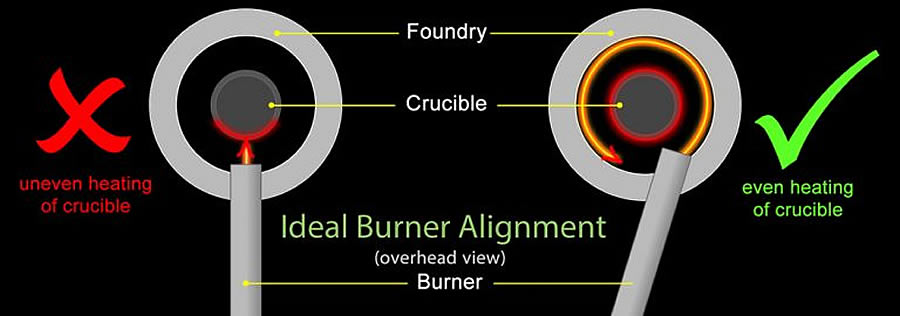Aluminum Foundry Wisconsin ensures reliable casting performance
Exactly How Aluminum Foundry Adds To Developments in Aerospace Design
Aluminum factories are important to developments in aerospace design. They produce lightweight, high-strength elements that are crucial for modern aircraft. With innovative casting methods, these foundries create intricate geometries that enhance architectural integrity. Furthermore, the development of superior Aluminum alloys sustains the market's emphasis on gas efficiency and sustainability. Nonetheless, difficulties continue to be in the manufacturing process. Understanding these aspects exposes the profound influence of Aluminum on air travel's future.
The Importance of Lightweight Products in Aerospace Design
As the aerospace sector remains to advance, the value of lightweight products comes to be progressively evident. The demand for effectiveness and sustainability drives designers to prioritize the usage of materials that lower total weight without compromising architectural honesty. Light-weight products, specifically Aluminum, play a crucial function in improving gas effectiveness, enhancing haul capacity, and increasing the total performance of airplane.
The integration of these products allows for ingenious designs, allowing suppliers to develop more aerodynamic shapes that can endure extreme conditions. The reduction in weight not only lowers operational expenses however likewise adds to a reduced environmental footprint, lining up with global initiatives toward sustainability in air travel.
Advanced Casting Techniques in Aluminum Foundries
Advanced spreading methods in Aluminum foundries play an important function in aerospace engineering by allowing the manufacturing of accurate and lightweight components. Innovations in mold style and precision casting processes are vital in attaining ideal efficiency and structural integrity. Furthermore, the advancement of light-weight alloys improves the overall performance and effectiveness of aerospace applications.
Ingenious Mold Layout
Ingenious mold design plays a vital role in the performance and efficiency of Aluminum foundries, especially within the aerospace field. By leveraging sophisticated products and techniques, modern-day molds can be crafted to withstand heats and stress, guaranteeing peak performance throughout the spreading process. These styles often include complex geometries that permit for the production of light-weight yet structurally sound parts, necessary for aerospace applications. Furthermore, the use of computer-aided layout (CAD) software program promotes accurate modeling, allowing foundries to imitate and fine-tune mold styles prior to physical manufacturing starts. This not only enhances the quality of cast parts but also reduces waste and preparation, leading to significant expense financial savings. Generally, cutting-edge mold layout is a cornerstone of progression in Aluminum Foundry innovation for aerospace design.
Accuracy Casting Processes
The efficiency of ingenious mold and mildew layouts seamlessly integrates with precision casting procedures, which are essential for creating high-grade Aluminum elements in aerospace engineering. These processes, including sand casting, die casting, and financial investment casting, guarantee the production of intricate geometries with tight tolerances. Advanced methods like vacuum spreading and pressure pass away casting boost the integrity and surface finish of the end products. Precision casting reduces material waste while making best use of the mechanical buildings of Aluminum, essential for aerospace applications. Furthermore, utilizing real-time tracking and advanced simulation devices throughout the spreading process permits immediate adjustments, causing enhanced quality assurance. Jointly, these accuracy casting procedures placement Aluminum shops at the center of aerospace innovation, supporting the market's need for dependability and performance.
Light-weight Alloy Advancement
As aerospace designers seek to enhance gas efficiency and efficiency, lightweight alloy development ends up being an essential emphasis in Aluminum factories. These foundries employ innovative spreading techniques to develop alloys that offer premium strength-to-weight ratios. Developments in alloy make-up, including the incorporation of components like lithium and magnesium, allow the production of products that withstand severe conditions while decreasing overall aircraft weight. Methods such as die spreading and financial investment spreading assist in the precision production of complicated forms, which are crucial for aerospace applications. In addition, continuous research intends to maximize these alloys for improved mechanical residential properties and increased longevity. By prioritizing light-weight alloy growth, Aluminum factories significantly add to the advancement of aerospace design, paving the method for a lot more efficient and lasting airplane layouts.

Enhancing Architectural Honesty With Aluminum Parts
Aluminum elements supply substantial benefits in boosting architectural honesty within aerospace design. Their light-weight nature contributes to overall effectiveness while keeping toughness, which is essential for aircraft performance. Furthermore, the stress and anxiety resistance residential properties of Aluminum assistance ensure the durability and reliability of aerospace structures under numerous functional conditions.
Lightweight Material Benefits
While typical products typically compromise weight for strength, making use of Aluminum elements in aerospace design uses substantial benefits in structural integrity. Aluminum's light-weight nature adds to general style efficiency, permitting for more structured aircraft that take in less fuel, thus improving sustainability. The product's superb strength-to-weight proportion assurances that components maintain durability without including unneeded mass. This quality promotes enhanced efficiency and dexterity in flight, along with optimized payload abilities. In addition, Aluminum's resistance to deterioration extends the life expectancy of aerospace frameworks, minimizing upkeep prices and boosting safety. As manufacturers Extra resources increasingly take on Aluminum alloys, the aerospace market experiences a transformative change towards much more effective and reliable engineering remedies that prioritize both efficiency and environmental duty.
Stress Resistance Qualities
Although different materials have special properties, Aluminum's remarkable anxiety resistance stands apart as an important consider boosting the architectural stability of aerospace elements. This resistance plays an important duty in making sure that airplane can withstand different operational tensions, consisting of exhaustion, influence, and ecological problems. Aluminum alloys, especially crafted for aerospace applications, exhibit high tensile stamina while keeping light-weight characteristics, making it possible for engineers to develop extra efficient structures - Aluminum Foundry. Furthermore, the capacity of Aluminum to withstand cyclic loading without considerable deformation adds to the longevity and reliability of aerospace components. As advancements proceed in Aluminum Foundry methods, the development of stress-resistant Aluminum elements promises more enhancements in performance, safety and security, and performance throughout the aerospace sector, solidifying Aluminum's duty as a recommended product in contemporary engineering
Gas Efficiency Improvements Driven by Aluminum Innovations
As the aerospace sector looks for to improve fuel efficiency, innovative uses Aluminum have actually arised as an essential remedy. Aluminum's lightweight nature especially minimizes aircraft weight, allowing for reduced fuel intake during trip. This reduction in weight is important, as even small decreases can bring about considerable enhancements in general fuel economic climate.
Advanced Aluminum alloys, developed for enhanced strength and durability, allow suppliers to develop elements that keep structural honesty while lessening mass - Aluminum Foundry. Furthermore, the integration of Aluminum in airframes and engine parts helps with boosted the rules of aerodynamics, adding to decreased drag and increased effectiveness
The fostering of Aluminum in aerospace not only meets the demand for fuel-efficient layout however also lines up with regulative stress for lower discharges. As these developments remain to develop, they play a significant function in establishing new criteria for gas performance, guaranteeing that the aerospace field can meet growing economic and environmental difficulties.

The Function of Aluminum in Sustainable Aeronautics Practices
The increasing emphasis on sustainable aviation methods has placed Aluminum as a necessary product in the quest for greener airplane layout. Recognized for its lightweight residential properties, Aluminum considerably minimizes aircraft weight, causing lower fuel intake and discharges. Its recyclability even more enhances its sustainability account, as Aluminum can be reused forever without loss of high quality. This characteristic sustains a round economic situation within the air travel industry, reducing waste and source exhaustion.
In addition, developments in Aluminum alloys have enhanced their toughness and rust resistance, permitting longer life span and minimized maintenance requirements. These innovations assist in the development of a lot more effective airplane frameworks, try this adding to total sustainability initiatives. Additionally, Aluminum's thermal conductivity plays an important duty in energy-efficient designs, boosting systems such as warm exchangers. Collectively, these features emphasize Aluminum's critical role in advancing sustainable aeronautics, aligning with international initiatives focused on reducing the environmental influence of flight.
Difficulties Faced by Aluminum Foundries in Aerospace Production
While Aluminum factories play a vital duty in aerospace production, they deal with significant obstacles that can influence manufacturing effectiveness and top quality. One major obstacle is the stringent top quality control standards needed in the aerospace sector. Any kind of problem can endanger safety and security and performance, necessitating extensive inspection processes that expand production timelines. In addition, shops typically compete with varying raw material prices, which can affect pricing and earnings. The intricacy of Aluminum alloys made use of in aerospace applications more makes complex the manufacturing process, as accurate formulas are critical for achieving desired mechanical buildings. Furthermore, proficient labor lacks prevent the ability to maintain top quality production levels. Ecological guidelines enforce constraints on exhausts and waste administration, needing factories to spend in lasting techniques, which can be cost-prohibitive. These aspects collectively create a landscape where Aluminum shops need to continually adjust to meet the progressing needs of aerospace manufacturing while guaranteeing safety and conformity.
Future Patterns in Aluminum Applications for Aerospace Engineering
With advancements in technology and raising needs for effectiveness, the future of Aluminum applications in aerospace design is positioned for considerable change. The integration of cutting-edge Aluminum alloys and composites is expected to enhance strength-to-weight proportions, bring about even more fuel-efficient airplane styles. In addition, innovations in additive manufacturing techniques will certainly enable for the production of intricate Aluminum frameworks that were previously impossible, maximizing performance and lowering waste.

Sustainable methods will play a necessary duty, with a growing emphasis on reusing Aluminum to lessen ecological influence. The aerospace field is likely to embrace smarter manufacturing processes, such as automation and man-made knowledge, ensuring higher high quality and precision in Aluminum components. Additionally, cooperations in between Aluminum shops and aerospace companies will certainly foster research study and advancement, leading the way for new applications that meet the stringent requirements of modern aerospace engineering - Aluminum Foundry. Generally, the future looks assuring for Aluminum's function in shaping the skies
Regularly Asked Inquiries
What Are the Ecological Impacts of Aluminum Production in Aerospace?
The ecological impacts of Aluminum manufacturing in aerospace consist of considerable energy consumption, greenhouse gas emissions, and environment disturbance. Furthermore, mining processes can bring about dirt deterioration and water contamination, raising problems regarding sustainability and environmental balance.
How Does Aluminum Contrast to Various Other Materials in Aerospace Applications?
Aluminum offers an unique combination of lightweight residential or commercial properties, deterioration resistance, and cost-effectiveness contrasted to various other materials. Its high strength-to-weight ratio makes it particularly helpful for aerospace applications, improving fuel efficiency and total efficiency in aircraft layout.
What Certifications Do Aluminum Foundry Employees Demand for Aerospace Projects?
Aluminum Foundry workers call for specialized training in metallurgy and casting strategies, together with expertise of aerospace industry criteria. Certifications in top quality control and safety protocols are likewise vital to assure conformity with strict aerospace task needs.
Exist Any Safety And Security Problems With Utilizing Aluminum in Aerospace Design?
Safety issues regarding Aluminum in aerospace engineering include susceptibility to deterioration, tension, and exhaustion cracks. Proper treatment and alloy choice are important to mitigate these threats, guaranteeing structural stability and overall safety in aerospace applications.
Exactly How Does Aluminum Recycling Benefit the Aerospace Industry?
Aluminum recycling significantly profits the aerospace market by minimizing material prices, decreasing ecological effect, and preserving power. This lasting technique enhances the sector's efficiency while promoting making use of light-weight, high-performance components in aircraft manufacturing.
Advanced spreading methods in Aluminum factories play a crucial duty in aerospace design by enabling the production of lightweight and exact components. Cutting-edge mold and mildew style plays a vital role in the efficiency and performance of Aluminum shops, especially within the aerospace market. As aerospace resource engineers look for to improve gas performance and efficiency, lightweight alloy advancement comes to be a necessary focus in Aluminum shops. Aluminum alloys, especially crafted for aerospace applications, display high tensile strength while keeping lightweight qualities, allowing engineers to develop a lot more efficient structures. Partnerships in between Aluminum shops and aerospace companies will foster study and growth, leading the method for new applications that satisfy the rigorous demands of contemporary aerospace engineering.